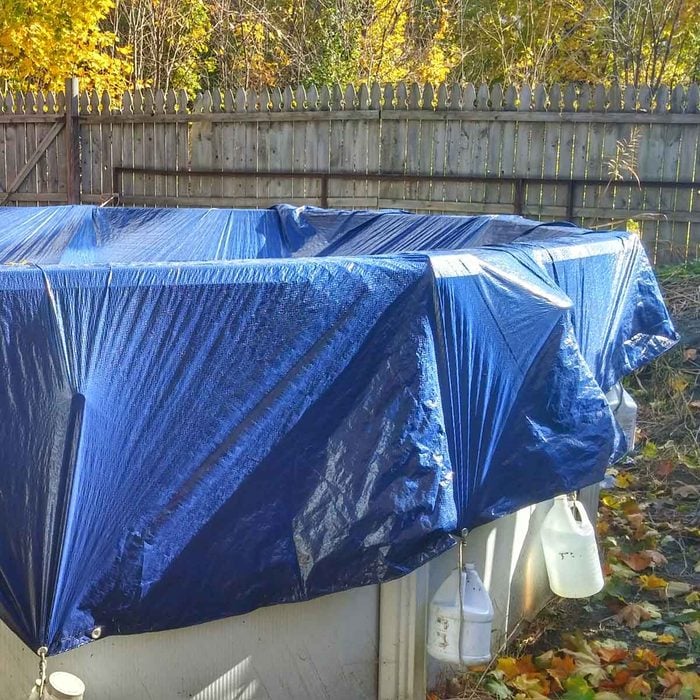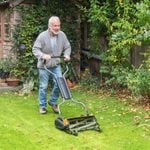Top Tips for Maintaining an Above Ground Pool

Here are 10 above ground pool maintenance tips to help keep everything in good shape.
Our editors and experts handpick every product we feature. We may earn a commission from your purchases.
Above ground pools are less expensive, easier-to-install alternatives to in-ground pools. And if that weren’t enough, they’re also usually easier to maintain. There are a few things you’ll want to do to keep your above ground pool in good working condition. Here are 10 key tips for above ground pool maintenance.
On This Page
Install a Sump Pump in Your House
This tip isn’t so much for your pool as it is for your house, but it’s an important one. Chuck Naish, founder of City Residential Foundation Repair, says many people neglect to install a sump pump in their basement when they buy an above ground pool. “If any leak were to spring, a sump pump would prevent all kinds of water damage and hazardous mold and mildew growth,” he explains.
Test the Chlorine Level
Chlorine is essential for pool water because it kills harmful algae, bacteria and microorganisms. Unfortunately, chlorine breaks down when exposed to the sun and chemicals from sunscreen, sweat and more. A pool should have a chlorine level between two and four parts per million (ppm). Make sure your above ground pool has enough by testing your water about every other day with chlorine test strips, such as these Aqua Chek Test Strips. Learn more about maintaining your pool’s chemicals.
Do Weekly Shock Treatments
Laurie Wilkins, founder of Call Outdoors blog, recommends giving your pool a weekly shock treatment like HTH Super Shock. A shock treatment involves using a powdered form of chlorine to kill algae, bacteria and other contaminants. “A shock treatment once a week will oxidize the contaminants, freeing up the chlorine and letting it do its work in cleaning up the water,” he says.
Test the pH Level
Wilkins also says that it’s essential to test and maintain your pool’s pH to keep the water crystal clear. “Having pH levels outside the range of 7.2 to 7.6 can reduce the effectiveness of the chemicals you put in your pool,” he says. Wilkins recommends digital readers like VIVOSUN pH and TDS Meter Combo to make the job quick and easy. Experts recommend testing the pH about every other day.
Run the Pool’s Pump at Least Eight Hours a Day
Your pool’s pump keeps the water circulating. That’s important because moving water is less likely to grow algae. Moving water also directs more debris into the filter to keep your pool water clean and clear. Experts recommend running an above ground pool pump at least eight hours a day. (For a more exact time for your specific pool, consult your pool pump’s owner’s manual.)
Regularly Clean and Replace the Filter
There are several kinds of pool filters, but they all have the same job: capturing debris that can cloud and pollute your pool. Hardworking pool filters should be cleaned about once a week by removing and hosing down the cartridge. It’s also important to replace the cartridge when it’s time, based on the manufacturer’s recommendation.
Regularly Clean Out the Pump and Skimmer Baskets
A pump basket collects debris before it can reach the pump, while a pool skimmer pulls in water from the pool’s surface. A skimmer captures leaves and other debris in a basket before it enters the filtration system. It’s important to clean out the pump and skimmer baskets at least once a week. (Empty them more frequently if there are lots of trees around your pool.) Always turn off the pool pump and heater before you clean out the baskets.
Vacuum Often
Not even the best filtration system can remove all the debris from a pool. That’s why it’s good to use a pool vacuum at least once a week. Vacuuming keeps the pool water clear, helps prevent algae growth, and lets chemicals such as chlorine work better. There are many types of pool vacuums on the market, but many people prefer robotic vacuums made especially for above ground pools, such as the Dolphin E10 Automatic Robotic Pool Cleaner.
Use a Solar Blanket
A solar blanket not only keeps your pool water protected from rain and debris, it also helps heat your pool via solar energy and reduce evaporation. “A solar blanket can reduce thermal loss by 95 percent,” says Steve Goodale, a writer and technical specialist who reaches millions of pool and spa owners each year through his Swimming Pool Steve resource blog and YouTube channel. That can lead to big savings on energy costs. Use a solar blanket anytime the pool isn’t in use.
Winterize Properly
If you can’t disassemble and store your above ground pool, you’ll want to take steps to properly winterize it. Give it a good final cleaning; balance the chemicals; add special winterizing chemicals to the water; clear, remove and store the pool lines; removing and store the skimmer (or protect it with a skimmer cover); pack away the filter, pump and pool accessories such as ladders; lower the water level if you don’t remove the skimmer; and cover the pool with a pool air pillow and cover. It may surprise you, but pool pros advise that above ground pools should not be drained before winter. Here’s how to drain a pool for passive winterization.



